人教版新目标九年级全册Unit6教学设计(英语教案)
- 格式:doc
- 大小:22.00 KB
- 文档页数:3
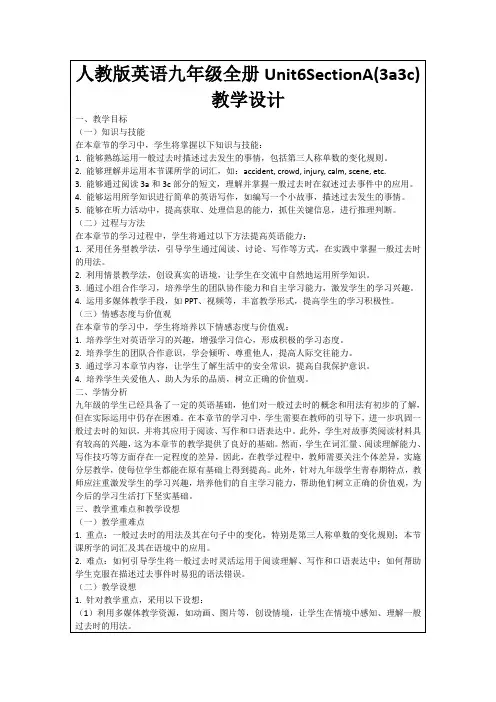
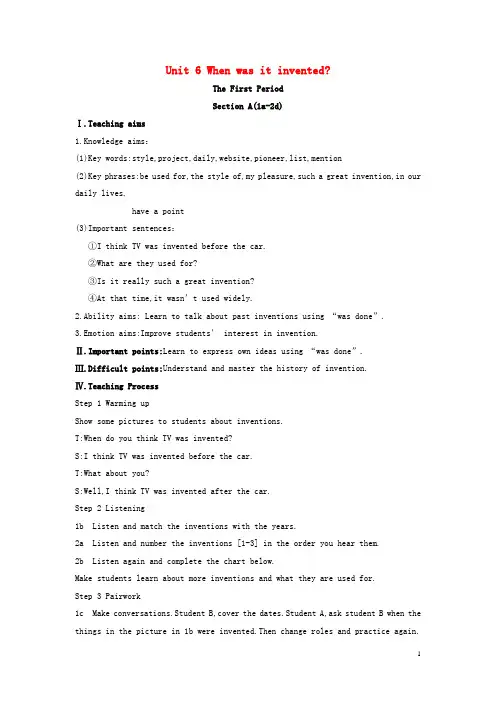
Unit 6 When was it invented?The First PeriodSection A(1a-2d)Ⅰ.Teaching aims1.Knowledge aims:(1)Key words:style,project,daily,website,pioneer,list,mention(2)Key phrases:be used for,the style of,my pleasure,such a great invention,in our daily lives,have a point(3)Important sentences:①I think TV was invented before the car.②What are they used for?③Is it really such a great invention?④At that time,it wasn’t used widely.2.Ability aims: Learn to talk about past inventions using “was done”.3.Emotion aims:Improve students’ interest in invention.Ⅱ.Important points:Learn to express own ideas using “was done”.Ⅲ.Difficult points:Understand and master the history of invention.Ⅳ.Teaching ProcessStep 1 Warming upShow some pictures to students about inventions.T:When do you think TV was invented?S:I think TV was invented before the car.T:What about you?S:Well,I think TV was invented after the car.Step 2 Listening1b Listen and match the inventions with the years.2a Listen and number the inventions [1-3] in the order you hear them.2b Listen again and complete the chart below.Make students learn about more inventions and what they are used for.Step 3 Pairwork1c Make conversations.Student B,cover the dates.Student A,ask student B when the things in the picture in 1b were invented.Then change roles and practice again.A:When was the telephone invented?B:I think it was invented in 1876.2c Make conversations using the information in 2b.Role-play the conversation.Step 4 Read and act2d Ask students to read the conversation in 2d by themselves.Listen to the tape and repeat after it.Work in pairs and then correct their mistakes.Language points1.invent的用法invent v.发明invention n.发明inventor n.发明者Edison was a great inventor.He invented a lot of things.爱迪生是一个杰出的发明家,他发明了许多东西。
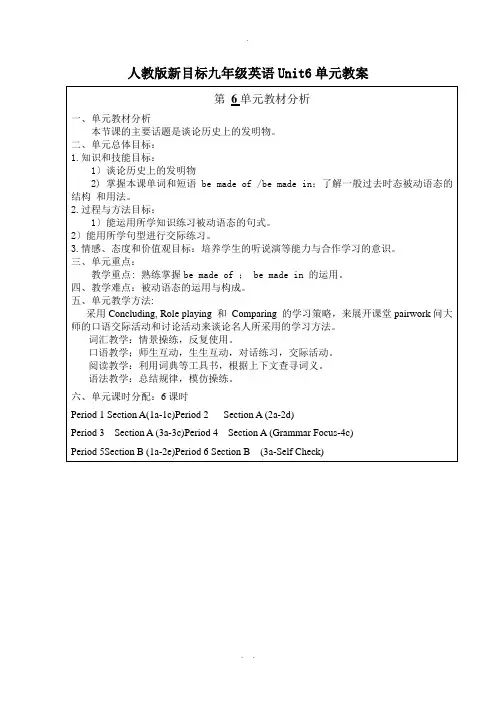
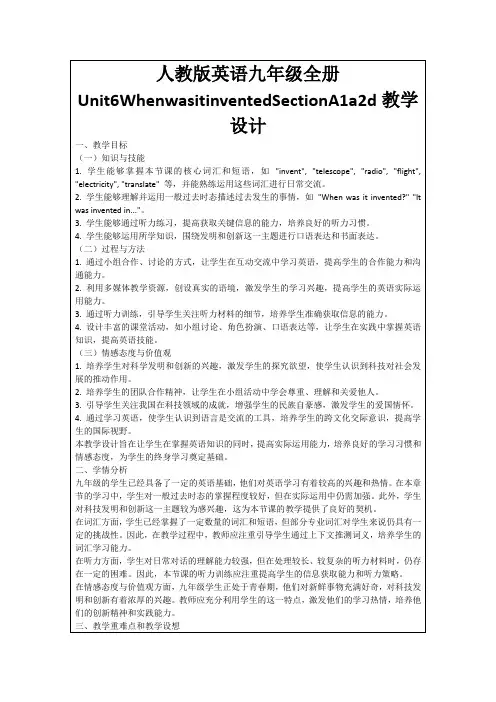

九年级英语全册Unit6Whenwasitinvented 教案(新版)人教新目标版Unit 6 Do you know when basketball was invented 词组,有用表达1. the safety of…. ….的安全…from…/prevent…from…2. knock into 撞到…上阻止……做某事_3. fall down 摔倒 of doing 梦想做….4. the aim of ……的目的doubt毫无疑问5. shoot from below the basket up to 钦佩;仰慕导致从篮下投球 24. not only.. but also…不但……而6. guide…into 引导…进入…且……7. It is believed…被认为 our daily life 在我们的日常生活8. in history 在历史上中9. since then 自从那时 about考虑;思考 10. over the open fire 在明火上that time在那时 Olympics 奥林匹克运动会widely used by 被广泛使用 a point 有道理有道理last=in the end 最后,终于 accident偶然;意外地 the same time 同时into掉入 a hard wooden floor place发生;出现在坚硬的木制地板上 . . into 把…翻译成… 32. at a low price 以低的价格 of a sudden突然;猛地similar to与……相似 mistake 错误地is said 据说…… ... into把分开;分成若干较 sth. out想出小的部分… from 使分开,隔开句子1. When was tea first drunkmost popular drink in the world was invented by accident.’s said that a Chinese ruler called Shen Nong was the first to discover tea as a drink.leaves from a tea plant fell into the water and remained there for some time. book describes how tea plants were grown and used to make tea. 6.—When was the telephone invented —I think it was invented in 1876. —What are they used for—They are used for seeing at night.知识点点拨一、see sb doing 看到某人正在做某事如:I saw him playing basket on the playground. see sb do 强调动作全过程(do 是省略to的不定式) I saw him go into that room. 如果变为被动to不省略He was seen to go into that room.1see sb done 表宾语和动词之间是被动的关系。
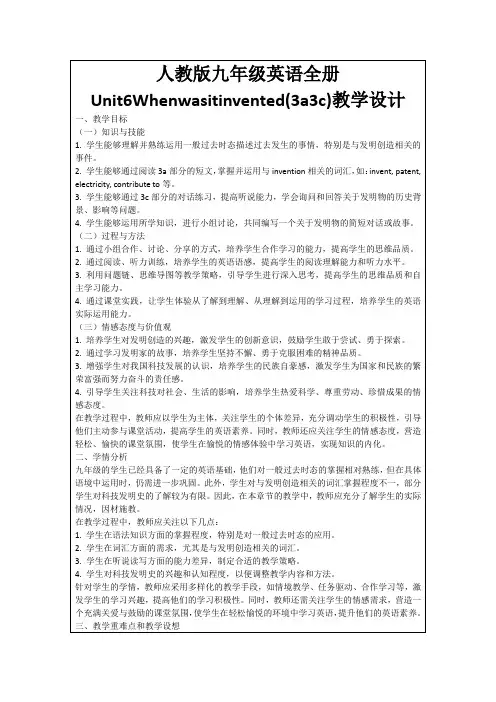
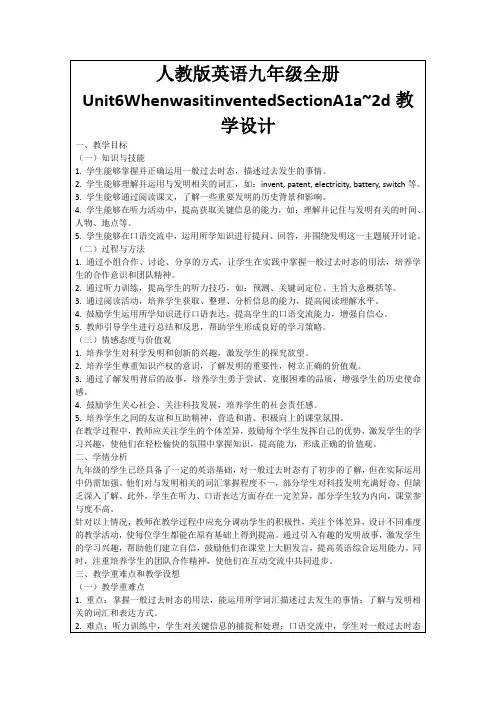
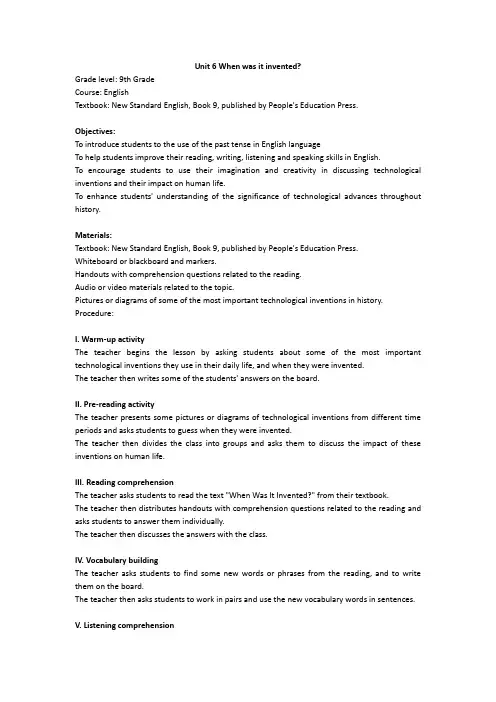
Unit 6 When was it invented?Grade level: 9th GradeCourse: EnglishTextbook: New Standard English, Book 9, published by People's Education Press.Objectives:To introduce students to the use of the past tense in English languageTo help students improve their reading, writing, listening and speaking skills in English.To encourage students to use their imagination and creativity in discussing technological inventions and their impact on human life.To enhance students' understanding of the significance of technological advances throughout history.Materials:Textbook: New Standard English, Book 9, published by People's Education Press.Whiteboard or blackboard and markers.Handouts with comprehension questions related to the reading.Audio or video materials related to the topic.Pictures or diagrams of some of the most important technological inventions in history. Procedure:I. Warm-up activityThe teacher begins the lesson by asking students about some of the most important technological inventions they use in their daily life, and when they were invented.The teacher then writes some of the students' answers on the board.II. Pre-reading activityThe teacher presents some pictures or diagrams of technological inventions from different time periods and asks students to guess when they were invented.The teacher then divides the class into groups and asks them to discuss the impact of these inventions on human life.III. Reading comprehensionThe teacher asks students to read the text "When Was It Invented?" from their textbook.The teacher then distributes handouts with comprehension questions related to the reading and asks students to answer them individually.The teacher then discusses the answers with the class.IV. Vocabulary buildingThe teacher asks students to find some new words or phrases from the reading, and to write them on the board.The teacher then asks students to work in pairs and use the new vocabulary words in sentences.V. Listening comprehensionThe teacher plays an audio or video clip related to the topic, and asks students to listen carefully. The teacher then distributes handouts with comprehension questions related to the clip and asks students to answer them.VI. Writing activityThe teacher asks students to write a short paragraph about one of the most important technological inventions in history and its impact on human life.The teacher then asks students to exchange their writing with a partner, and to provide feedback on each other's writing.VII. Follow-up activityThe teacher concludes the lesson by asking students to share their opinions about the impact of technological inventions on human life, and how they think technology will continue to shape our future.Assessment:The teacher can assess students' performance through the following:Observing their participation in class discussions and group activities.Reviewing their answers to comprehension questions.Assessing their writing activity and providing feedback.Observing their use of new vocabulary words in sentences.Homework assignment for "When Was It Invented?" lesson:Research and write a brief report about one of the most important technological inventions in history and its impact on human life.Write a dialogue between two people discussing the importance of technological inventions in their lives.Watch a video or read an article about a recent technological invention and write a summary of it.Create a timeline of technological inventions from prehistoric times to the present day, including the approximate date of each invention and its impact on human life.Choose one of the vocabulary words from the lesson and write a short story using that word correctly.Practice reading aloud the text "When Was It Invented?" from your textbook, paying attention to your pronunciation and intonation.Think about how technology has changed your life and write a short paragraph about it.Note: Students should submit their homework assignments in the next class meeting.。
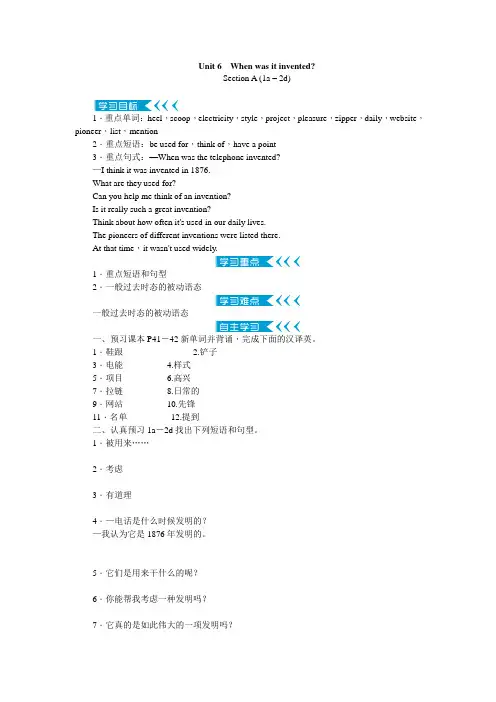
Unit 6When was it invented?Section A (1a-2d)1.重点单词:heel,scoop,electricity,style,project,pleasure,zipper,daily,website,pioneer,list,mention2.重点短语:be used for,think of,have a point3.重点句式:—When was the telephone invented?—I think it was invented in 1876.What are they used for?Can you help me think of an invention?Is it really such a great invention?Think about how often it's used in our daily lives.The pioneers of different inventions were listed there.At that time,it wasn't used widely.1.重点短语和句型2.一般过去时态的被动语态一般过去时态的被动语态一、预习课本P41-42新单词并背诵,完成下面的汉译英。
1.鞋跟________ 2.铲子________3.电能________ 4.样式________5.项目________ 6.高兴________7.拉链________ 8.日常的________9.网站________ 10.先锋________11.名单________ 12.提到________二、认真预习1a-2d找出下列短语和句型。
1.被用来……________________________________________________________________________ 2.考虑________________________________________________________________________ 3.有道理________________________________________________________________________ 4.—电话是什么时候发明的?—我认为它是1876年发明的。

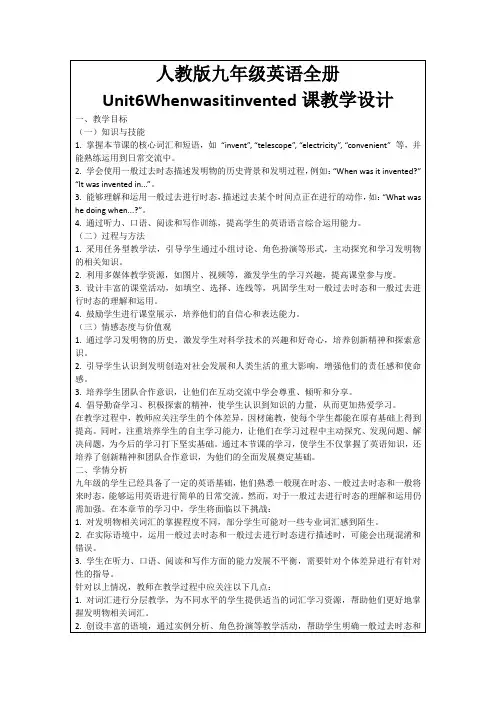
人教版新目标英语九年级第六单元教案设计
Unit 6 I like music that I can dance to.
Section A Period 1
一、教学内容分析
本单元的话题主要是谈论个人的喜好,本节课主要是让学生运用定语从句来介绍自己喜欢的音乐类型。
音乐无国界,进而谈论和我们日常生活密切联系的话题。
二、教学背景分析
大部分学生热爱英语,喜欢用英语来表达自己的观点和想法,本课的话题与生活实际联系较为密切,能够锻炼学生运用英语进行交际的能力。
三、教学设计说明
本课通过不同种类的音乐,谈论学生自己的喜好,主要是应用定语从句这一语法,可以说,本节新课是对这一语法的具体操练。
本课使用多媒体课件教学,用不同类型的音乐的图片、乐曲来吸引学生,激发学生学习的积极性。
同时,能让音乐这门无国界的语言愉悦学生的心灵。
附:
教师个人介绍:
靳慧琴:从事英语教学三年,工作在教学第一线,参加过英语教学公开课比赛并取得一定的成绩。
本人喜爱自己从事的英语教学工作,经常用英语和自己的学生谈谈心,在素质教育实施的过程中,竭尽所能,不断追求着……。
Unit 6 When was it invented ?
Grammar and Writing
Teaching Aims
1. Knowledge objects:
(1) The students will be able to use the patterns be done in the given situations or daily life.
(2) The students will be able to use the following phrases: be invented in ; be used for doing ; be invented by … to make sentences.
2. Ability objects:
(1)The students will be able to get the information needed in reading.
(2) The students will be able to talk about and write the information about their inventions using target language.
3. Emotion & attitude
Enable the students to have the spirit of creating new things and love our mother land, study hard to achieve our dreams.
Important and difficult points:
The students will be able to use be done structure correctly in speaking and writing practice.
The students will be able to adopt correct reading and writing strategies. Teaching approach and means:
Task-based Teaching Approaches. multimedia
Teaching procedures
Grammar
Step 1 Lead-in
( Show some pictures of the Great Wall .)
T: What’s this ?
Ss: The Great Wall.
T: It is the symbol of China and it is famous all over the world ,right ?
But what was it used for ?
(Ask one student to answer .)
Step 2 Pair work
A: What was it used for ?
B: It was used for sending messages.
T: Be used for…is Passive Voice.
More practice:
A : When was it invented ?
B: It was invented in…
A: Who was it invented by ?
B: It was invented by…
A: What is it used for?
B: It is used for…
A: What do you think of it ?
B: I think it…
Some exercise.
Reading
Step 1 Read and fill in the blanks.
Check the answers.
Pay attention to the structure of the passage .
Step 2 More reading
1.T: Here is a passage about inventions ! Go through the picture with the students.
2. Let the students read again and answer the questions below the passage.
(Then check the answers and let the students to choose the reading strategy they adopted in reading and share it in class.)
Groupwork
Step 1 Cooperate to design
T: Well done dear students! Now it’s time to cooperate to design. Discuss these problems in your group and we’ll show your design to see which group is the best one. Ask students to have a discussion in groups and then design their own tools. All the problems should be solved by themselves.
Step 2 Share the designs in class
Everyone in the group are supposed to say something about their inventions . Each of them have a chance to talk in class.(Give them the standards about how to make an estimate of each invention. Let the students show their own ideas about other inventions. ) Writing
1. Write their own introductions of their design.
2. Share the passages in class so that the students can learn more information about each invention. In this way each student can improve their own writing ability.
Ending:
T: As the hosts of the 21st century , we have the duty to make our country stronger and stronger ,what should we to do to achieve our China Dream ?
Ss: We should study hard!
Together : Let’s study hard and achieve our China Dream !!
Homework:
T: In this class all of you did very well, and you helped me a lot, thank you! Here’s today’s homework:
1. Rewrite the articles .
2. What else do you want to invent in the future ?
Tell us something about your ideas next class.。